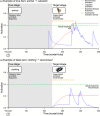A Linguistic-Sensorimotor Model of the Basic-Level Advantage in Category Verification
- PMID: 39715230
- PMCID: PMC11666073
- DOI: 10.1111/cogs.70025
A Linguistic-Sensorimotor Model of the Basic-Level Advantage in Category Verification
Abstract
People are generally more accurate at categorizing objects at the basic level (e.g., dog) than at more general, superordinate categories (e.g., animal). Recent research has suggested that this basic-level advantage emerges from the linguistic-distributional and sensorimotor relationship between a category concept and object concept, but the proposed mechanisms have not been subject to a formal computational test. In this paper, we present a computational model of category verification that allows linguistic distributional information and sensorimotor experience to interact in a grounded implementation of a full-size adult conceptual system. In simulations across multiple datasets, we demonstrate that the model performs the task of category verification at a level comparable to human participants, and-critically-that its operation naturally gives rise to the basic-level-advantage phenomenon. That is, concepts are easier to categorize when there is a high degree of overlap in sensorimotor experience and/or linguistic distributional knowledge between category and member concepts, and the basic-level advantage emerges as an overall behavioral artifact of this linguistic and sensorimotor overlap. Findings support the linguistic-sensorimotor preparation account of the basic-level advantage and, more broadly, linguistic-sensorimotor theories of the conceptual system.
Keywords: Basic level; Categories; Concepts; Linguistic distributional; Sensorimotor.
© 2024 The Author(s). Cognitive Science published by Wiley Periodicals LLC on behalf of Cognitive Science Society (CSS).
Conflict of interest statement
We have no conflicts of interest to disclose.
Figures







Similar articles
-
The effects of sensorimotor and linguistic information on the basic-level advantage.Cognition. 2023 Dec;241:105606. doi: 10.1016/j.cognition.2023.105606. Epub 2023 Sep 16. Cognition. 2023. PMID: 37722237
-
Linguistic Distributional Knowledge and Sensorimotor Grounding both Contribute to Semantic Category Production.Cogn Sci. 2021 Oct;45(10):e13055. doi: 10.1111/cogs.13055. Cogn Sci. 2021. PMID: 34647346
-
Sensorimotor distance: A grounded measure of semantic similarity for 800 million concept pairs.Behav Res Methods. 2023 Oct;55(7):3416-3432. doi: 10.3758/s13428-022-01965-7. Epub 2022 Sep 21. Behav Res Methods. 2023. PMID: 36131199 Free PMC article.
-
The challenge of abstract concepts.Psychol Bull. 2017 Mar;143(3):263-292. doi: 10.1037/bul0000089. Epub 2017 Jan 16. Psychol Bull. 2017. PMID: 28095000 Review.
-
Situation models, mental simulations, and abstract concepts in discourse comprehension.Psychon Bull Rev. 2016 Aug;23(4):1028-34. doi: 10.3758/s13423-015-0864-x. Psychon Bull Rev. 2016. PMID: 26088667 Free PMC article. Review.
Cited by
-
Specificity effect in concrete/abstract semantic categorization task.Cogn Process. 2025 Sep 3. doi: 10.1007/s10339-025-01286-5. Online ahead of print. Cogn Process. 2025. PMID: 40900400
References
-
- Barsalou, L. W. , Niedenthal, P. M. , Barbey, A. , & Ruppert, J. (2003). Social embodiment. In Ross B. (Ed.), The psychology of learning and motivation (Vol. 43, pp. 43–92). Academic Press.
-
- Barsalou, L. W. , Santos, A. , Simmons, W. K. , & Wilson, C. D. (2008). Language and simulation in conceptual processing. In De Vega M., Glenberg A. M., & Graesser A. C. (Eds.), Symbols and embodiment: Debates on meaning and cognition (pp. 245–283). Oxford University Press.
MeSH terms
Grants and funding
LinkOut - more resources
Full Text Sources

